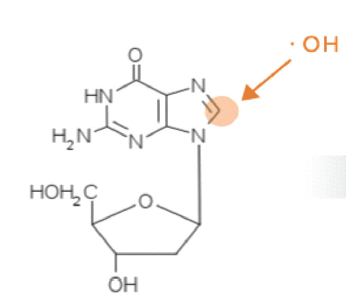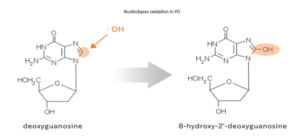

The ROS attack on the carbon in position eight of Gua oxidizes it into 8-OHGua and the non-oxidized nucleoside 2-dG into 8-OHdG.
Oxidative damage on nucleobases and Hoehn–Yahr stage in Parkinson’s disease
AMERICAN JOURNAL OF RESEARCH IN MEDICAL SCIENCES
Andrea Bolner, Manuela Pilleri, Ottavio Bosello, Giampietro Nordera
The imbalance between reactive oxygen species and the antioxidant barrier is a typical condition of Parkinson’s disease (PD), and maybe the cause of oxidative alterations on DNA. The oxidation of nucleobase guanine (Gua) has been previously widely studied and the measurements of the hydroxylated form 8-hydroxy-Gua (8-OHGua) and its nucleoside 8-hydroxy-2-deoxy-guanosine (8-OHdG) have been proposed as sensible and reliable markers of this imbalance. Nucleobases oxidation
Objective:
The study was carried out to demonstrate the relations between 8-OHGua, 8-OHdG, and the corresponding non-oxidized nucleoside 2-deoxy-guanosine (2-dG) with PD clinical progression.
Method:
The measurements of 8-OHGua, 8-OHdG, and 2-dG were performed in urine samples of 198 PD subjects, ranked according to the Hoehn–Yahr scale (H–Y). The same analysis was also performed in a group of 33 subjects with other parkinsonisms.
Results:
All markers were analyzed by using a high-performance liquid chromatography and electrochemical detection. For 8-OHGua, a new method was specifically optimized; the low limit of detection (10 ng/l) and good intra- and inter-assay coefficients of variation (2.2% and 3.6%, respectively), allowed reliable measurements of 8-OHGua in a wide range of concentrations (from 0.5 to 2,000 μg/l). Compared to the initial stages (H–Y < 2), 8-OHdG doubles in advanced ones (H–Y > 2) and 2-dG halves, both with statistical significance (p < 0.001). Furthermore, 8-OHdG increased more in males than in females, and its level was higher in parkinsonism than in PD. Even the values of 8-OHGua increased with the aggravation of the pathology, but in a less marked way and without statistical significance.
Conclusions: Nucleobases oxidation
The redox imbalance in PD causes oxidative damage on DNA that increases with the progression of the disease. By attributing to 8-OHdG the role of marker of extent of oxidative damage, to 8-OHGua the one of efficiency of removal of oxidized bases from DNA, and to 2-dG the one of recovery of native nucleosides for the replacement of oxidized ones, our data seem to show that the DNA repair mechanisms in PD are insufficient to counteract the chronic oxidative insult that characterizes the disease.
